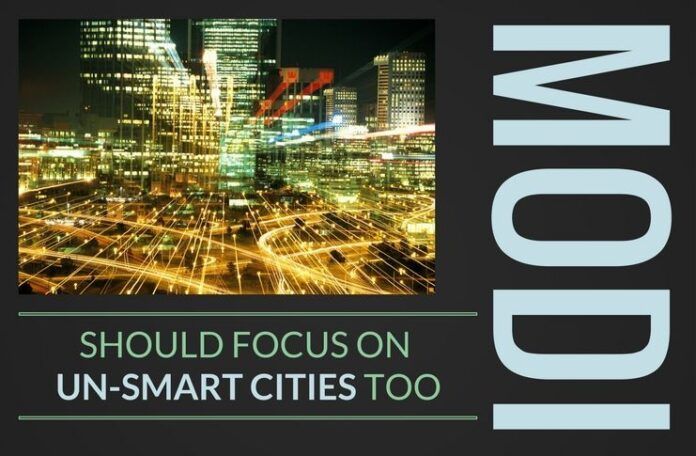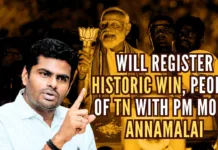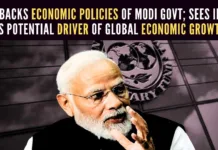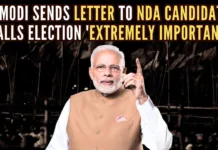
[dropcap color=”#008040″ boxed=”yes” boxed_radius=”8px” class=”” id=””]I[/dropcap]f a picture is worth a thousand words, last Friday authored an epic on the sinking cities in Narendra Modi’s India. The epic—comprising flooded metropolises, tormented commuters, baffled administrators, bumbling and bickering politicians, and the slamming of the system by the mainstream and social media—should be the epiphanous moment for the Prime Minister and his bhaktas.
They had changed the name of Gurgaon, making it Gurugram (which is also called ‘Millennium City’ by proud Indians). Perhaps the underlying belief, and the wish, was that the Hindutva-compliant name would make evaporate all the problems that have come to be associated with Gurgaon. If wishes were horses, Modi’s cavalry would transform the nation. But that, unfortunately, is not to be.
For the infrastructure has remained rickety ever since Manohar Lal Khattar took charge as Chief Minister of Haryana; at any rate, if he and his administration have made any improvements in this regard, they are not visible, evident from the massive traffic jam. This earned the national Capital’s satellite town a new name—Gurujam. Vehicles inched their way on National Highway 8, as a watercourse carrying storm-water, called the Badshahpur Drain, got breached. There was huge water-logging in the surroundings and the clogging of the arterial road for long hours. Road Minister Nitin Gadkari had to direct the National Highways Authority of India (NHAI) to rush officers to Gurgaon where chaos reigned; Section 144 had to be imposed in the area; schools have been shut down for two days. A spell of heavy rain had sunk the Millennium City and brought the administration to its knees.
[dropcap color=”#008040″ boxed=”yes” boxed_radius=”8px” class=”” id=””]I[/dropcap]n fact, last week proved terrible for India’s metropolises. The commercial capital, Mumbai, also touted as ‘Maximum City,’ had monster jams on Thursday; people were seen fishing on the roads of Bangalore, the so-called Silicon Valley of India or IT Capital of India; earlier, Hyderabad, another IT hub, had suffered heavily because of downpour.
Evidently, neither the political class nor the civic authorities have learnt any lessons from the deluge in Chennai last year and in Mumbai a few years earlier. Thankfully, the Prime Minister is an honorable and important exception to the generally navel-gazing political class. He is at least trying to do something about urban revival.
But Modi faces two big problems: one, he is dependent upon the characters like Khattar and Maharashtra Chief Minister Devendra Fadnavis; and, two, Modi is being driven astray by his own fondness for the majestic and the spectacular, a testimony to which is his Smart Cities Mission.
[dropcap color=”#008040″ boxed=”yes” boxed_radius=”8px” class=”” id=””]T[/dropcap]he official document on the subject says: “In the approach of the Smart Cities Mission, the objective is to promote cities that provide core infrastructure and give a decent quality of life to its citizens, a clean and sustainable environment and application of ‘Smart’ Solutions. The focus is on sustainable and inclusive development and the idea is to look at compact areas, create a replicable model which will act like a light house to other aspiring cities. The Smart Cities Mission of the government is a bold, new initiative.”
Such verbiage flies in the face of ubiquitous overflowing sewers, flood roads, monster jams, frequent power cuts, inadequate water supply, mushrooming shanty towns and the so-called unauthorized colonies, and general urban decay. The need of the hour is a crackdown on the derelict civic authorities all over the country, more transparency and people’s participation in local affairs, and proper oversight by the state and Central governments. This calls for scrutiny of existing rules and regulations concerned, extensive file work full of drudgery, and carrying out unsexy assignments. All this cannot be substituted with technology and technocracy. For technology and technocracy can be tools to enhance governance, not its replacement. Futuristic phrases will not help Modi improve governance in urban India.
It is time Modi pulled himself out of the spell of shiny, sexy, and technocratic fantasies. Epiphany can be a good spell-breaker, but will it happen? Let’s see.
- Liberty Is Penalized, Violence Goes Untouched - December 21, 2019
- Rahul’s Howdy bloomer - September 22, 2019
- Chidambaram’s hypocrisy - August 22, 2019











Small towns, large villages and even small cities must be developed in the lines planned for ‘Smart cities’with all infrastructure for independent sustenance.These will be easier to implement.cheap, participatory, devoid of chaos and easy for administration.It can also avoid avoidable urban congestion.Infrastructure like water, electricity, sewerage, drainage, garbage disposal,gas supply can be planned independently.
Let’s call them’ common sense ‘cities and establish thousands of them.